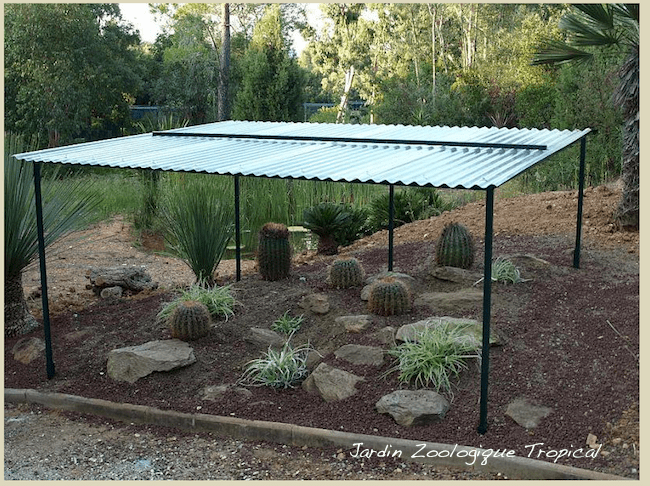
Succulents and Too Much Rain, A French Solution
Want to protect your succulents from too much rain? Here's how the Jardin Zoologique Tropical in southeastern France keeps their succulents from becoming waterlogged during seasonal rainstorms. Corrugated fiberglass panels atop metal bars tent the plants so excess rain doesn't soak the soil.

The structures are tall enough to allow good air circulation, and the panels are translucent, enabling maximum sunlight to reach the plants. The covers, which have a horizontal metal rod atop them so wind can't lift them, also protect tender succulents from frost.
Notice, too, that the plants grow in rocky, elevated, sloping soil, so water drains away from the roots.

You might do something similar in your own garden with a patio umbrella secured in a concrete base. But keep in mind that the water has to go somewhere. The French garden's panels channel rain onto the gravel roadway nearby.
Btw, this public garden, located near the village of La Londe-les-Maures, is deservedly proud of its succulent collection. Here's a description from the website, courtesy of Google Translate. The common names of the plants are charming.
Our plant collection is rich in many varieties of succulent plants: agaves, aloes and euphorbias. Every season their blooms transform the gardens. We regularly introduce little-known species and observe them for their ornamental potential. Perhaps the best known are cacti native to the Americas. We grow several species hardy in our climate. Some are globular, like the famous "mother-cushions," others are elongated, cylindrical and commonly called "candle cactus." Visitors easily identify the "prickly pear," also called "Mickey Mouse ears" or "cactus rackets."
(Photos used with permission.)
Related info
On this site:
How to Water Succulents These fleshy-leaved plants from hot, dry regions are designed to live off water stored in their leaves and tissues in order to survive periods without rainfall. But this doesn't mean you shouldn't water them at all...[Continue reading]
Prepare Your Succulents for Rainstorms Succulents, which come from arid climates, may rot. Stems or trunks turn squishy and collapse. It may be possible to… [Continue reading]
Learn about pumice. No other soil amendment is as widely used by succulent growers and collectors as pumice (crushed lava rock). Here’s why...[Continue reading]
Oh, No, My Succulents Froze! Will succulents recover from frost damage? It depends. Here’s how frost-tender succulents looked before temps dropped into the mid-20s F, and after...[Continue reading]
Caring for Your Succulent Garden After Rainstorms, Checklist Rain at last! Could the California drought finally be over? Well, no. It’ll take hundreds of years for underground aquifers...[Continue reading]
Winter Protection for Succulents: Products Soggy soil, dim light, high humidity and freezing temperatures can be death to succulents native to warm, arid climates. These items will help you get your succulents through cold, wet North American winters...[Continue reading]
On My YouTube Channel:
Above: Is your garden set to handle the excess? It can be death to succulents to overwater them, yet under certain circumstances, they can handle much more than they need.

Fabulous idea! I live in one of the most challenging climates to garden with temps in the mid 30%C, 80-90% humidity and torrential monsoon rains, as tropical as Malaysia in summer in winter it’s a completely different beast from the east, mostly bone dry and cool with temps averaging in the low 20’s but with short minimums of 8-9%C. My planting is limited. Too tropical and wet in summer for most sub-tropical plants too cool in winter for most tropical plants. Anyway not to let a mere trifle like weather get in the way I indulge in my passion for the succulent Aloe family which I adore. Suddenly there are also a vast array of incredible hybrids of these being marketed by various growers around the globe, primarily Australia, America and of course South Africa where they’ve in fact been created by the genius plantsmen and hybridiser of “Sunbird Aloes”. Stunning colours sizes and forms of flower and plant and incredibly floriferous. So not to let a good thing pass me by I used everything under the sun (rain) to protect and grow them. I use everything from umbrellas to small shelters just like these shown here, sometimes just for one feature plant, others for a group. It works very well but is quite a chore keeping them watered just the right amount as they more or less dont get a drop of rain grown this way. The ambient humidity seems not to affect them much and in fact seems to rather help if Im lax with watering in the growing season.
I noticed in these shelters shown here the corrugated fibre glass panels are orientated so the corrugated channels created are against the flow of water and gradient of the roof, away from the drainage areas. Is this intentional? Am I missing something here?
Lovely post very close to my heart, thanks. Im always interested to see what kind of open structures people use to keep rain off plants as I am constantly thinking of ideas myself. Most commercial products are unattractive and geared towards vegetable production, or they’re small closed cloche type things. So I have to have my ideas constructed for me from scratch. I like the simplicity of these French ones, they’re rather attractive but they can of course also be features in their own right and this is where I am at the moment. Designing for functionality without distracting from the plants, but still thinking of ways to make them more garden worthy without being too literal. Thanks for the tip meantime!